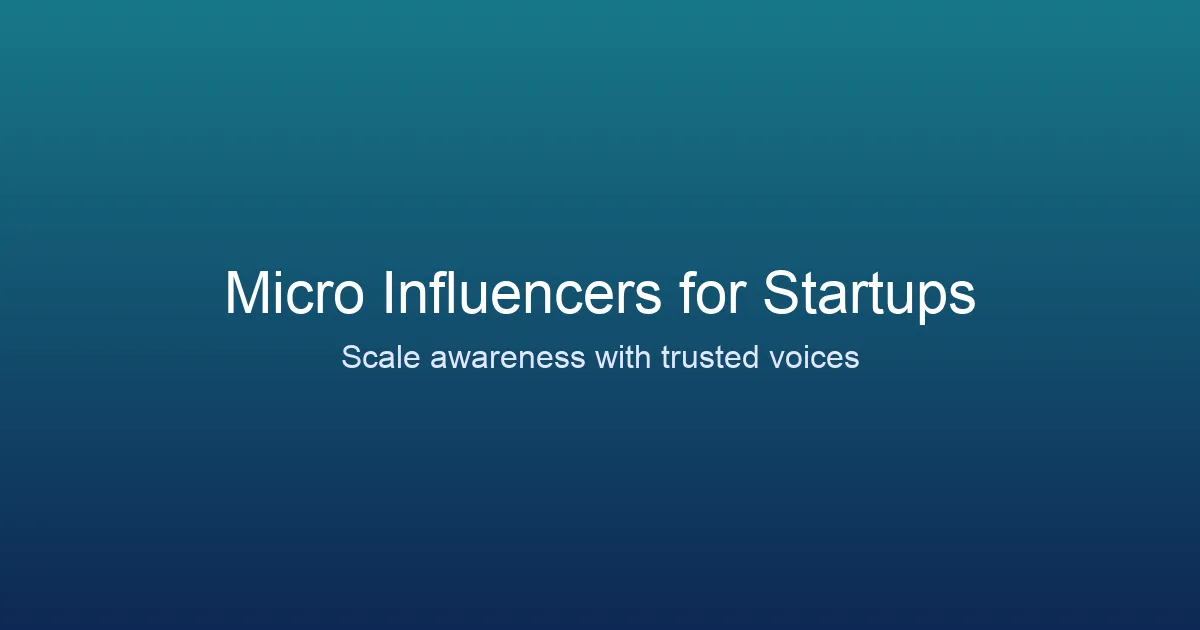
How Tech Startups Are Using Micro-Influencers to Explode Brand Awareness
How Tech Startups Are Using Micro-Influencers to Explode Brand Awareness
High-growth startups rarely have the luxury of giant ad budgets—or the time to wait for brand campaigns to mature. Micro-influencers bridge that gap. With 10K to 100K followers and deeply engaged communities, they function like trusted field marketers who speak the language of your users. Here’s how tech founders are tapping micro-influencers to scale awareness fast.
Why Micro-Influencers Work for Tech
- Credibility beats hype: Followers view them as peers who test tools, share honest feedback, and answer questions in DMs.
- Niche reach: Whether you’re selling developer APIs or productivity AI, there’s a micro community designed for it.
- Cost control: Fees stay manageable, enabling startup teams to run multiple experiments in parallel.
- Content density: Creators produce demos, reviews, and tutorials that can be repurposed across paid, web, and lifecycle channels.
Blueprint for a Startup Micro-Influencer Program
- Clarify your north-star metric. Decide whether you’re optimizing for beta signups, booked demos, or community growth.
- Define three core personas. Translate customer interviews into influencer attributes—job role, tech stack, community platforms.
- Source creators with CrowdCore. Filter by niche, audience authenticity, and past sponsored content to build a qualified list.
- Craft a “share, don’t sell” brief. Provide product access, story angles, and a clear CTA that feels natural to their audience.
- Launch in waves. Start with five creators, analyze conversion paths, then expand to 15–20 once messaging sticks.
- Recycle winning assets. Turn top-performing posts into ads, email content, and onboarding resources.
Playbooks by Startup Stage
- Pre-launch / Beta: Partner with builders and analysts who can offer constructive critique and drive early waitlist signups.
- Seed to Series A: Combine explainers from micro creators with community Q&As to educate prospects and reduce trial friction.
- Growth Stage: Layer in industry micro-influencers for thought leadership while maintaining nano advocates for grassroots community momentum.
Metrics to Prove Impact
- Attributed signups or demos: Use UTMs and promo codes to track conversion.
- Engagement quality: Analyze comment depth, shares, and saves to gauge resonance.
- Pipeline velocity: Measure time from influencer touchpoint to qualified opportunity.
- Content reuse ROI: Quantify earned media value by tracking how long assets perform across channels.
- Community growth: Monitor Discord, Slack, or newsletter subscribers sourced from creator posts.
Toolkit Essentials
- CrowdCore discovery & outreach: Automate vetting, briefing, and campaign tracking.
- Customer intelligence platforms: Sync with tools like Pocus or Breadcrumbs to see how influencer cohorts move through the funnel.
- Product analytics: Use Mixpanel, Amplitude, or June to analyze activation rates from creator traffic.
- Advocacy platforms: Layer in tools like G2, Capterra, or social proof widgets to amplify testimonial clips.
Regional Playbook
- North America: Blend LinkedIn-first B2B micro creators with YouTube reviewers who unpack features for technical audiences.
- Europe (EMEA): Localize briefs for multilingual creators; lean on community hosts in Berlin, Paris, and London to drive event attendance.
- APAC: Activate micro influencers on platforms like YouTube Shorts, Xiaohongshu, and Lemon8 to capture cross-border e-commerce attention.
- Latin America: Pair micro creators in fintech and SaaS hubs (São Paulo, Mexico City, Bogotá) with bilingual content that doubles for US Hispanic audiences.
Turn Micro Communities into Macro Growth
The startups winning mindshare are the ones shipping with their community—not at it. Micro-influencers unlock that closeness at speed. Use CrowdCore to uncover the right voices, automate outreach, and keep every campaign tied to revenue. When your product shows up in the feeds people already trust, awareness isn’t a guessing game—it’s a growth engine.